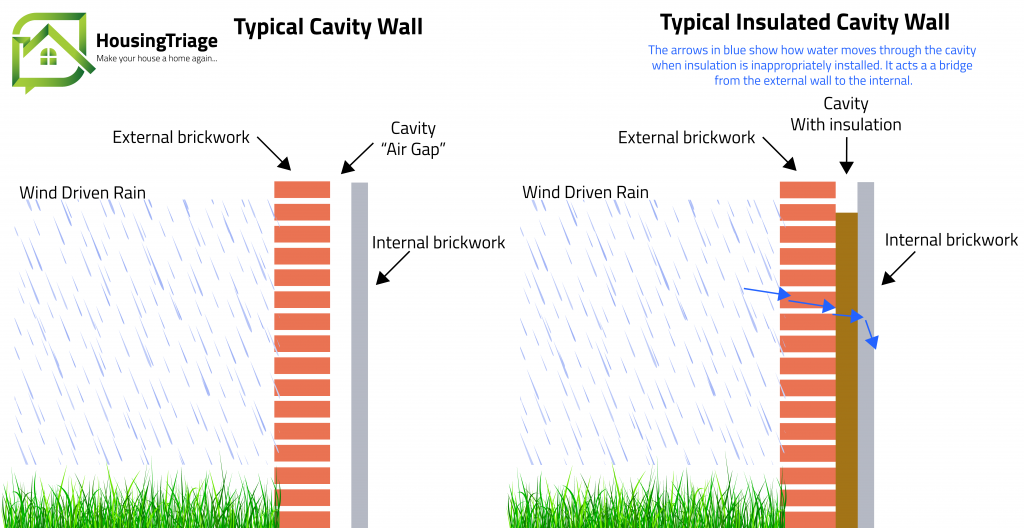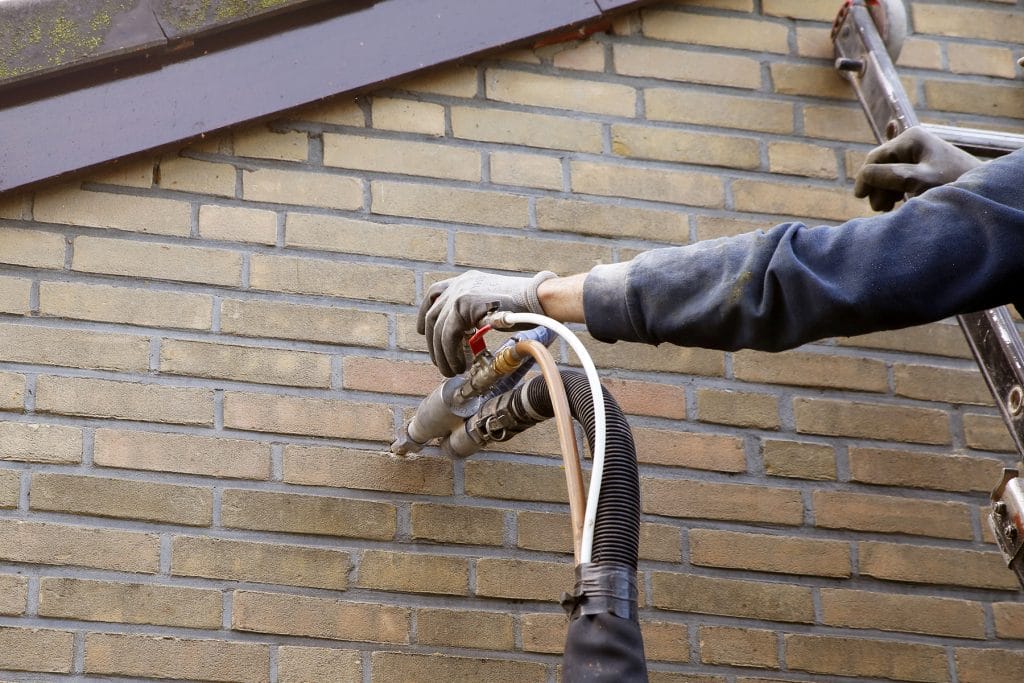We look at the signs that you should look out for in case your Cavity Wall Insulation (CWI) isn’t working properly and consider whether it is the best cause of action is removing cavity wall insulation?
What Are The Benefits of Cavity Wall Insulation?
After loft insulation, CWI is the next best type of insulation in terms of cost effectiveness; so you’re probably thinking why would I consider removing cavity wall insulation? It can help to lower your energy bills, it keeps the heat in and stops the cold getting in making your home more energy efficient.
However, it has now come to light that cavity wall insulation is not the answer to everyone’s energy problems. Millions of homes across the UK are showing signs of failed cavity wall insulation, with homeowners reporting damp, mould and cold stops on their walls. This is due to varying factors such as: poor installation, degradation, and inappropriate application.
Why was cavity wall insulation installed
In the 80’s building regulations stated that when constructing new buildings that the cavities should be installed with insulation. The government wanted to make homes more energy efficient as well as reducing energy bills this is why the building regulations came in, so a lot of these slightly older properties did not have insulation installed initially.
The only way that this insulation could be installed after they had been fully constructed was by an injection process into the cavity, using cheap materials along with a relatively simple installation. At this time, it showed great results in terms of energy efficiency, so the Government really pushed for homes to have this installed. The government incentive and relatively simple installation process lead to thousands of small installation companies trying to ‘get there hands on a piece of the pie.’ However this meant that any property with a cavity wall was targeted, some of these companies had no regard as to whether the property was actually suitable for this type of insulation or not.
What makes a property unsuitable for cavity wall insulation?
The most common answer to this question is location. Studies have shown that properties situated on the west coast of the UK are not suitable due to the wind-driven rain coming from the Atlantic
- As mentioned before walls that are exposed to wind driven rain that have been fitted with CWI, have been done so inappropriately – this is commonly seen in coastal regions. In these properties the cavity is there to stop water travelling into the home, as bricks are slightly porous they absorb water. When the cavity is filled with CWI it acts as a bridge transferring the rainwater from the external brickwork to the internal, this can very quickly lead to damp issues inside your home.
- The original material, Urea-formaldehyde used for CWI was not tested thoroughly enough, in the case of this material in recent years we have been finding that firstly it begins to breakdown. Meaning that it falls to the bottom of the cavity, meaning the top parts of the wall have no insulation leading to cold spots on the walls. Secondly when it does breakdown it releases a carcinogenic gas into the air called formaldehyde, potentially making a home inhabitable… so it is a necessity that if you have insulation made from this material, then you removing cavity wall insulation today.
- Terribly similar to the first point, when building regulations in the 1930’s first introduced the use of cavity walls, these cavities were very thin. It was to prevent porous bricks transferring rainwater from the external walls to the internal walls and to prevent damp issues in the home. When filled with insulation again it acts like a bridge, carrying the water from the outside walls to the inside walls.
- In some cases, we have found people being allergic to the materials used in the CWI. So, when they buy a new home that has previously had CWI installed, they are having to have they are removing cavity wall insulation despite the energy saving results of CWI.
- Poor and rushed installation which leads to areas where the insulation is not evenly distributed or there are gaps, leading to cold spots. During installation, the installer drills holes in the wall to inject the material in, if the distances between each hole were uneven then this problem would arise.
- Timber frame homes are another example of unsuitable properties that have been installed with CWI. There are cases of untrained or untrustworthy installers who have installed anyway to make sure they get paid for the job. These types of buildings need the cavity to be empty to allow moisture to escape, if this is filled with insulation it can trap the moisture in and cause rot to the timber frame. This is problematic for those selling houses with CWI as mortgage companies will not allow potential buyer’s mortgages on these properties until the CWI has been fully removed.
- Rushed and corner cutting installations have produced more problems later down the line, as installers were paid per m2, some tried to complete their jobs as quick as possible. A mix of uPVC glue and then beads are injected into the walls to produce the insulation, first applying the beads and then the glue to bind them, however this takes 3 times as long. Some installers would not bother with this and just inject the whole lot at once, to maximise the number of jobs they could complete. This has led to cases where the beads have settled at the bottom of the cavity. This has resulted in no real insulation benefit towards the top of the walls, again producing cold spots of which can lead to damp issues.

Removing Cavity Wall Insulation is it possible?
Yes, in the majority of cases removing cavity wall insulation is a very simple extraction process, however this depends on the type of material used in the insulation. Simply put if the insulation is wool based or has already began to degrade then material is removed using a massive hoover, however some bricks and mortar need to be removed from the bottom of the wall prior. For more solid insulation high pressurised air is blown into the walls using an, this breaks down the insulation and it can then be removed in the same way by using the ‘hoover’ method.
Does Removing Cavity Wall Insulation Damage Walls?
The process only involves compressed air, it is a very safe process. It has been reported that cavities will end up in better shape than before the insulation was added, as debris such as mortar, rocks and brick are also removed at the same time.
How Much Does Removing Cavity Wall Insulation Cost?
This depends entirely on a number of things and the exact building in question, for example size of the cavity, the material used etc. However as a guide prices range between £21 – £22 per m2 according to Check-A-Trade.
Can I Get Compensation From Poor Installation?
If you’ve had cavity wall incorrectly or poorly installed then, you can claim back on the cost of removing cavity wall insulation, meaning you won’t pay anything for having your home returned to how it was prior to the installation.
How Can Housing Triage Help With The Costs of Removing Cavity Wall Insulation?
Housing Triage are here to help you claim operating on a “No win, no fee” agreement, helping you claim compensation against the removal costs of the CWI. A surveyor will provide an estimate of the cost of any works needed to repair the damage to the property and place it back into the condition it was in prior to the CWI being installed.
If you’d like to book a free survey get in touch now.


